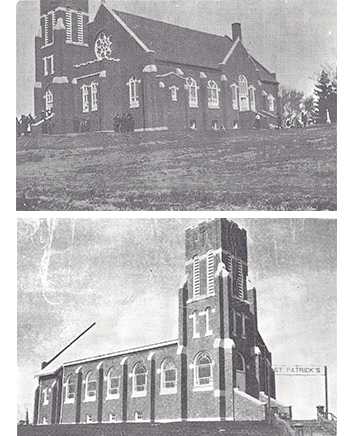

Quentin Minnehan and John Geisler


Early settlers from 1852 until 1872 worshiped in private homes visited infrequently by traveling missionaries. In 1872, Miles and Julia Fitzpatrick donated five acres of land to build a church and cemetery. The original church was a wood structure built of native lumber by the parishioners and carpenter Isaac Richie, who lived in the Kendrick township area near Horseshoe Bend, at the cost of $16,500. St. Patrick’s was the first Catholic church, parish and cemetery in Greene County, Iowa. The first trustees were Miles Fitzpatrick and Joseph Carroll. The cemetery was also established in 1872 and Jeremiah Mackey was the first burial in 1873. Before the cemetery was formed most people buried their dead in private gardens near their homes. They later moved them to St. Patrick’s. Therefore, some of the monuments bear dates prior to 1872.
In 1885, Bishop Hennessey of the Dubuque Diocese appointed Fr. George Costello as the first resident priest at St. Patrick’s who served Churdan and Lohrville until they also built churches around 1886, also overseen by Fr. George.
In 1915, due to the growing population, the original wooden church was replaced by a brick church under the guidance of the notable architect, William LeBarthe Steele, at the cost of $24,000. Two brick privies were also built southeast of the church to accommodate the public and remain there today as part of the historical fabric of the St. Patrick’s. In 1919, a few hours after Holy Trinity Sunday service, the church was destroyed by fire. Since there was no well, there was no available water to be used as a means to extinguish the fire so the public had to helplessly watch their beautiful church burn. Even today, there is no well or water in the church. It was hard times pending the Great Depression, but the faithful Irish Catholics rallied their strength and by 1920 they had completely rebuilt the beautiful St. Patrick’s Church as it stands today, using the original foundation and brick walls. The church is a matte-faced vitrified brick and stone church with a Romanesque Revival design. The building also exhibits a couple of elements of the Gothic Revival style of steeply pitched roof and rose window on the main façade. It is considered one of the best examples of Romanesque Revival styles in Greene County. (1)
In August 1996, the parish was reduced in status to an oratory. At least two Catholic masses are celebrated each year as well as weddings and funerals. Otherwise, the restored church and basement hosts events which include American Legion Memorial salute and decoration of the cemetery, Local Lion’s Club, Greene County Historical Society meetings and other private functions.
Scheduled tours are available by contacting Andy Geisler at 913-486-2909.
Reference:
(1) https://en.wikipedia.org/wiki/St._Patrick%27s_Catholic_Church,_Cedar